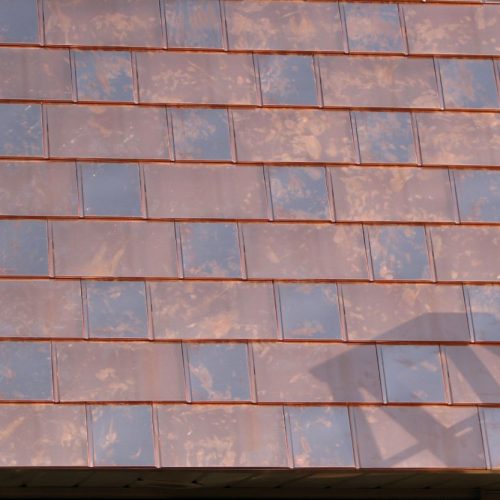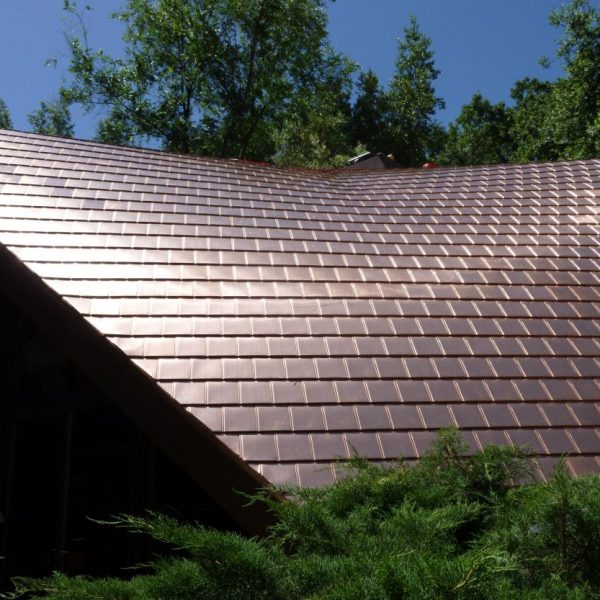Copper Natural Weathering
The natural weathering of copper to the characteristic blue-green or gray-green patina is a direct consequence of the mild corrosive attack of airborne sulfur compounds – principally stemming from the combustion of fossil fuels. In the atmosphere, these compounds combine with water vapor to form dilute oxidizing acids which react with copper surfaces.
As natural weathering proceeds, the metal exposed to the atmosphere changes in hue from the natural salmon pink color through a series of russet brown shades to light and dark chocolate browns and finally to a dark, dull slate gray or sooty black from which the ultimate blue-green or gray-green patinas spring. The initial transition from the natural salmon pink color to the russet browns stems from the formation of copper oxide conversion films on the exposed metal surface.

New Copper Roof

1 year after installation

5 years after installation

10 years after installation
It is Natural
During the initial weeks of exposure, particularly in humid atmospheres or in areas of frequent rainfall, radical color changes often take place with iridescent pinks, oranges and reds interspersed with brassy yellows, blues, greens and purples observed. These sometimes shocking color variations result from the initial formation of the oxide surface films which are so thin that rainbow-hued interference colors are seen. As the natural oxide film builds in thickness during continued exposure, the interference colors fade and are replaced by relatively uniform russet brown shades.
As weathering progresses, cuprous and cupric sulfide conversion films are interspersed with the initial oxide film. These sulfide conversion films range from chocolate brown to black. As they build, the exposed metal surface darkens appreciably. Continued weathering results in the conversion of the sulfide films to the basic copper sulfate patina.


The Science Behind It
In industrial and seacoast atmospheres, the natural patina generally forms in from five to seven years. In rural atmospheres, where the quantity of air-born sulfur dioxide is relatively low, patina formation may not reach a dominate stage for from ten to 14 years. In arid environments, the basic sulfate patina may never form due to the lack of sufficient moisture to carry the chemical conversion process to completion. Similarly, exposed horizontal surfaces develop the patina more rapidly than sloping surfaces which, in turn, patinate more rapidly than vertical surfaces. The critical variable, in all instances, is the dwell time of moisture on the exposed surfaces.
The progressive oxide, sulfide and sulfate films which develop on copper exposed to the atmosphere are quite thin – two to three thousandths of an inch – highly adherent, but with relatively low abrasion resistance. Neither the oxide nor sulfide films are particularly corrosion resistant. The sulfate patina, on the other hand, is highly resistant to all forms of atmospheric corrosion, once it has had an opportunity to form completely. It thus significantly increases the durability and hence, the service life of copper roofing and flashing.
Chemical Coloring
Although, as stated above, the natural weathering of copper to the ultimate sulfate patina yields the most durable installation, frequently, architects and/or building owners express’ the desire either to inhibit natural patina formation, in an effort to preserve the uniform russet brown or chocolate brown shades of the oxide and sulfide conversion films, or to hasten the patina formation through chemical means. There are potential drawbacks associated with both of these approaches which the architect or owner should be aware of before opting to proceed.
In architectural parlance, the natural forming or chemically induced oxide and sulfide conversion films on the surface of copper or its alloys are referred to as “statuary” or “oxidized” finishes. In color, they range from light russet brown to ebony. Chemical coloring of exposed flashings, chimney caps and similar small surface areas has been undertaken from time to time with reasonable success.

Because of the nature of the reaction of the coloring solutions with the metal surface, application to large surface areas such as roofs, spires and domes is deemed impractical, since color uniformity is difficult to control and the hand application methods employed are expensive. Where large areas are involved, therefore, natural weathering to the desired shade in encouraged, at which point, further color change can be retarded through the application of oil or wax to the weathered copper surface.
Except in arid climates, copper usually weathers to a uniform russet brown within six to 12 months of initial exposure to the atmosphere. In arid climates, due to the absence of moisture, the weathering process is significantly slowed. It may require several years of exposure for the copper to achieve the desired shade. In addition, the multi-hued interference colors, previously mentioned, may persist for months rather than days or weeks.
At times there is concern with regard to color variations during or immediately following installation of large expanses of copper roofing or flashing. Such color variations are common and usually transient tending finally to disappear as natural weathering proceeds. There are two principal sources for such color variations. One involves the storage conditions from the time of manufacture until the time of installation, while the second involves exposure conditions following installation. For both conditions, time is an important variable. Moisture is also a key factor.



Sizing & Installation
Once a copper sheet is sheared to size in the mill, it is usually packed in wood cases with a lining of moisture resistant kraft paper. When stored in a heated mill or warehouse, oxidation (the principal cause of color change) proceeds at a slow rate, since the environment is relatively dry and the copper surface is usually still coated with a thin film of rolling oil.
The first significant oxidation of the metal may occur when it is shipped. In transfer, the cases may be exposed to rain, snow or high humidity conditions on open loading docks. Temperature changes can cause condensation within the paper wrappings inside the case. With moisture present on the metal surfaces, oxidation accelerates. Lengthy storage in unheated premises can, and often does, produce similar results.
Once received by the installing contractor, the metal may be subject to storage conditions which promote continuing slow oxidation. Fabricated goods may be further exposed to the weather during shipment to and storage at the construction site prior to installation. When installed, oxidation is continuous, but the rate fluctuates depending on the amount and duration of moisture present, temperature changes, contaminants in the air, the sunshine and even wind velocity.
Since installation of large expanses of copper roofing may take weeks or even months depending upon weather conditions and working conditions, color variations can and frequently do result from differing lengths of exposure and climatic changes. Natural weathering eventually produces uniform appearance in every case.
Only nature can produce copper.
Only Zappone can make it so easy to install and so easy to own.
Call 1-800-285-2677 or email us now for more information!

